Book contents
- Frontmatter
- Contents
- Preface
- Introduction
- PART I
- PART II
- 10 Curved space
- 11 Special relativity
- 12 General relativity
- 13 Black holes
- 14 Expansion of the universe
- 15 Redshifts
- 16 Newtonian cosmology
- 17 The cosmic box
- 18 The many universes
- 19 Observational cosmology
- PART III
- Appendix – Fundamental quantities
- Index
12 - General relativity
from PART II
Published online by Cambridge University Press: 05 June 2012
- Frontmatter
- Contents
- Preface
- Introduction
- PART I
- PART II
- 10 Curved space
- 11 Special relativity
- 12 General relativity
- 13 Black holes
- 14 Expansion of the universe
- 15 Redshifts
- 16 Newtonian cosmology
- 17 The cosmic box
- 18 The many universes
- 19 Observational cosmology
- PART III
- Appendix – Fundamental quantities
- Index
Summary
It is as if a wall which separated us from the truth has collapsed. Wider expanses and greater depths are now exposed to the searching eye of knowledge, regions of which we had not even a presentiment. It has brought us much nearer to grasping the plan that underlies all physical happening.
Herman Weyl (1885–1955), Space, Time, and MatterPRINCIPLE OF EQUIVALENCE
Gravitational and inertial forces produce effects that are indistinguishable – this is the principle of equivalence. It serves as an essential stepping-stone to the theory of general relativity, and makes a basic connection between motion and gravity. It leads to a second stepping-stone: the realization that geometry and gravity have much in common. Then, in an inspired leap across the gulf of non-Euclidean geometry, we enter a country into which comparatively few explorers have ventured. No person entering the third millenium may claim to have a liberal education who has not glimpsed, however briefly, the universe of general relativity.
An inertial force, such as centrifugal force, exists when a body is accelerated. We recall from Newtonian theory that when a body is in free fall, and hence moves freely in space under the influence of gravity, it follows a path of such a kind that the sum of the inertial and gravitational forces is zero. With items of knowledge such as these, sufficient to land men on the Moon, we have made our first step toward the theory of general relativity.
- Type
- Chapter
- Information
- CosmologyThe Science of the Universe, pp. 220 - 245Publisher: Cambridge University PressPrint publication year: 2000

